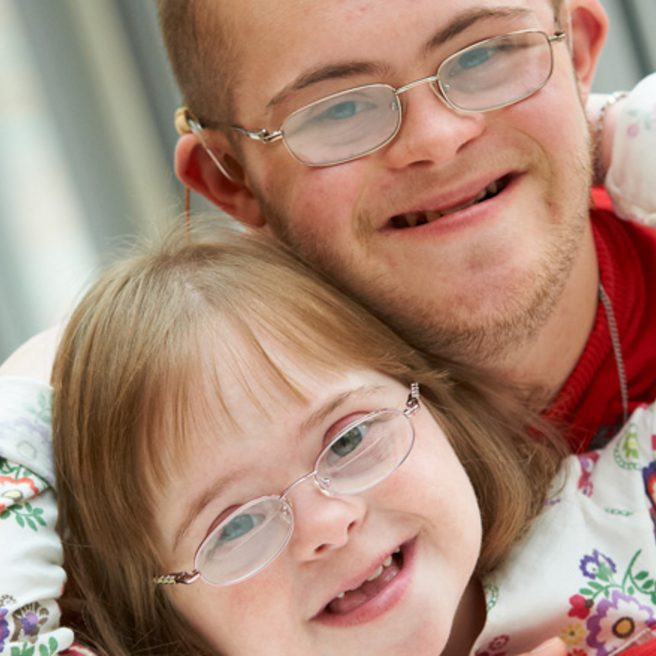What is Trisomy 21 (Down syndrome)?
Trisomy 21 is the most common chromosomal anomaly in humans, affecting about 5,000 babies born each year and more than 350,000 people in the United States.
Also known as Down syndrome, trisomy 21 is a genetic condition caused by an extra chromosome. Most babies inherit 23 chromosomes from each parent, for a total of 46 chromosomes. Babies with Down syndrome however, end up with three chromosomes at position 21, instead of the usual pair.
Other examples of trisomies occur at position 13 and 18. Trisomy 21 is the most common of the three, occurring in 1 out of every 691 births. The disorder was first identified in 1866 by John Langdon Down, a British physician, and later named after him.
As your child with Down syndrome grows, he is at greater risk for certain medical problems and may develop:
- Congenital heart disease
- Gastrointestinal abnormalities
- Musculoskeletal and movement problems
- Spine disorders such as scoliosis, kyphosis or lordosis
- Endocrinologic disorders
- Epilepsy
- Hearing loss
- Speech apraxia (difficulty making speech sounds)
- Sleep disorders
- Feeding disorders
- Developmental disabilities (learning disabilities, intellectual disabilities and autism)
Problems in any of these areas can affect your child's development and behavior.
Causes
Down syndrome occurs because of the extra copy of chromosome 21, which can cause the body and brain to develop differently than a child without the syndrome.
The risk of having a baby with Down syndrome increases as a woman ages — women older than 35 are often encouraged to have prenatal genetic testing done of their unborn babies — but, because younger women have more babies, they give birth to 80 percent of babies with Down syndrome.
Signs and symptoms
Symptoms of Down syndrome may include:
- Distinctive facial features
- Mild to moderate intellectual disabilities
- Heart, kidney and thyroid issues
- Numerous respiratory infections, from colds to bronchitis and pneumonia
- Skeletal abnormalities, including spine, hip, foot and hand disorders
- Flexible joints and weak, floppy muscles
- Overly quiet baby
- Less responsive to stimuli
- Vision and hearing impairment
- Inwardly curved little finger
- Wide space between the great and second toe
- Single, deep crease on the soles of the feet and one or both hands
Your Child's Trisomy 21 Program Visit
Learn more about what to expect at your first appointment with the Trisomy 21 Program clinic.
Testing and diagnosis
Tests to confirm Down syndrome are often done before a baby is born through amniocentesis or chorionic villus sampling (CVS). For amniocentesis, a needle is inserted through the mother’s abdominal wall into the amniotic sac and a small sample of amniotic fluid is drawn out and tested in a laboratory.
If your child was not prenatally diagnosed with Down syndrome, diagnosis usually begins at birth based on your child’s physical appearance. Doctors will ask you for a thorough family medical history, do a physical exam of your child, and analyze your child’s chromosomes. Once a diagnosis is made, additional testing may be ordered to help clinicians better understand how Down syndrome may affect your child and help spot any early complications from the disorder.
Tests may include:
- Genetic testing, in which a sample of your child’s saliva is used to identify your child’s DNA.
- Blood tests, which can help determine drug usage and effectiveness, biochemical diseases and organ function.
- X-rays, which produce images of bones.
- Magnetic resonance imaging (MRI), which uses a combination of large magnets, radiofrequencies and a computer to produce detailed images of organs and structures within the body.
- Computed tomography (CT) scan, which uses a combination of X-rays and computer technology to produce cross-sectional images ("slices") of the body.
- EOS imaging, an imaging technology that creates 3-dimensional models from two planar images. Unlike a CT scan, EOS images are taken while the child is in an upright or standing position, enabling improved diagnosis — for some conditions — due to weight-bearing positioning.
Treatments
There is no cure for Down syndrome. Treatment is ordered when certain issues — such as heart problems, muscle weaknesses or spinal curvatures — occur and need to be treated.
At Children’s Hospital of Philadelphia (CHOP), we practice collaborative, family-centered care. A team of expert clinicians — including world-class surgeons and physicians, pediatric nurses, physical and occupational therapists, psychologists and other specialists — will partner with you in the care of your child.
Many children with Down syndrome are also diagnosed with a variety of secondary conditions that are present at birth and can be treated when your child is young. This is often true for conditions such as heart issues, hand and foot anomalies.
In other cases, the complications from Down syndrome may only become evident — or problematic — as your child grows. This is often true for spinal deformities such as scoliosis and hip conditions that might require surgical correction.
Every child’s condition is different, so treatment is determined on a case-by-case basis. Depending on your child’s needs, specialists from cardiology, orthopedics, endocrinology and others will treat your child. Treatment may include therapy, surgery or additional support services for your child and family.
A Care Binder can help you organize the most important information about your child's care in a central place.
Follow-up care
Your child with Down syndrome should continue to be monitored by a physician into adulthood. Experts in the Trisomy 21 Program at CHOP are available to help you manage the care of your child with Down syndrome at all stages of growth. The Trisomy 21 Program is one of the few programs at Children's Hospital that treats patients beyond age 18 and into old age.
If your child had surgery, she will need to follow up with her surgeon about one to two weeks after surgery, then again at three and six months post-surgery. After that, annual monitoring by trained clinicians is strongly encouraged to ensure any problems are spotted and treated as soon as possible.
During follow-up visits, your child may need additional X-rays and other diagnostic testing done. The goal of continued monitoring is to help spot any irregularities in growth or development and to address health issues as they develop.
Follow-up care and ongoing support and services are available at our Main Campus and throughout our CHOP Care Network. Our team is committed to partnering with parents and referring physicians to provide the most current, comprehensive and specialized care possible for your child.
In addition, physicians may recommend your child see several different specialists because so many body systems can be involved in a diagnosis of Down syndrome.
For example, your child may see:
- An orthopedic physician for any bone- and muscle-related issues, particularly to diagnose and manage instability of the cervical spine, hip instability and the possibility of hip dislocation.
- A cardiologist for any heart-related issues. An echocardiogram may be ordered to create pictures of your baby’s heart to help diagnose or rule out heart defects.
- A pediatric audiologist, who is trained to identify, diagnose, treat and monitor hearing problems.
- A pediatric ophthalmologist (eye doctor), who can assess your child’s vision and diagnosis and treat eye or vision problems.
- A pediatric endocrinologist for a thyroid function test. Thyroid hormones play an important role in your child’s growth, development and metabolism. Thyroid levels are checked with a blood test.
- A geneticist for individual or family counseling.
- A pulmonologist for any breathing issues.
- A neurologist for any nerve and brain-related issues.
- Physical therapists and occupational therapists to expand your child’s physical dexterity and skill.
Trisomy 21 Toolkit for Transitioning to Adult Medical Care
This toolkit outlines steps for individuals with Down syndrome who are transitioning from pediatric to adult healthcare.
Outlook
In 1983, the life expectancy for people with Down syndrome was 25 years; however today, it is 60 years. Advances in cardiology have significantly contributed to this rapid increase. As science and technology continue to improve and the intricacies of Down syndrome are explored and discovered, it is expected that the life expectancy for people with Down syndrome will continue to increase too.
Today, children with Down syndrome are included in regular academic classrooms in schools across the country. In some instances they are integrated into specific courses, while in other situations students are fully included in the regular classroom for all subjects. The degree of mainstreaming is based in the abilities of the child.
Many people with Down syndrome have gone to college, live independently and hold jobs. These individuals are hard workers and dedicated employees. A stimulating home environment, positive support from family and friends, quality educational programs and good healthcare enable people with Down syndrome to develop their full potential and lead fulfilling lives. Be creative, persistent and set high expectations.
Despite the advances, children with Down syndrome continue to have a higher risk of developing certain health conditions, such as heart disease, gastrointestinal abnormalities and dementia. Early diagnosis and treatment of these associated conditions leads to better outcomes.
With regular medical care and a solid support system, children with Down syndrome can lead long, full and happy lives.
Resources to help
Trisomy 21 (Down Syndrome) Resources
Trisomy 21 Program Resources
We have created resources to help you find answers to your questions and feel confident with the care you are providing your child.

